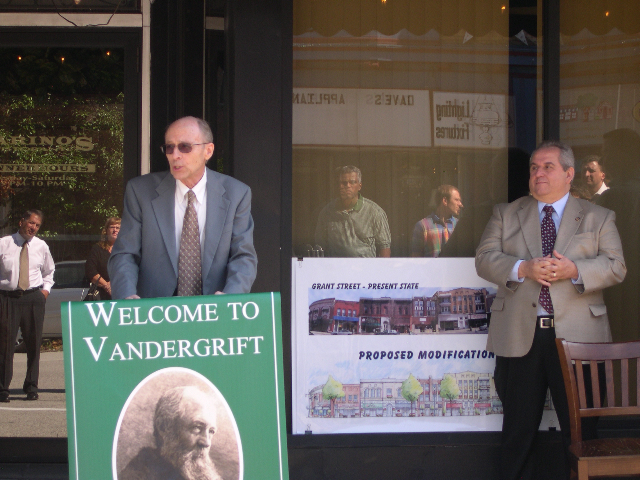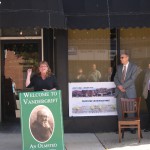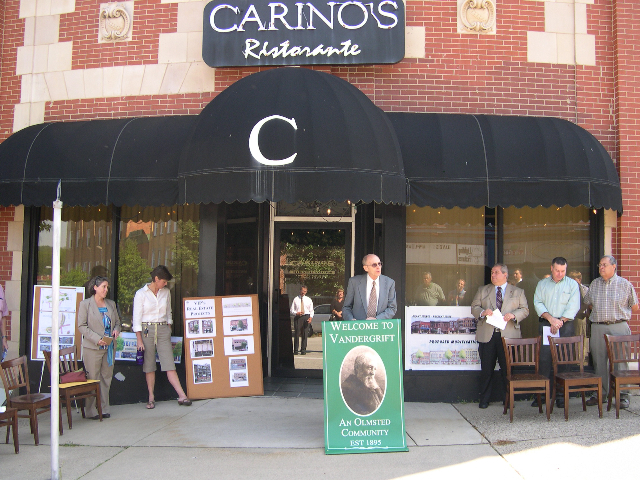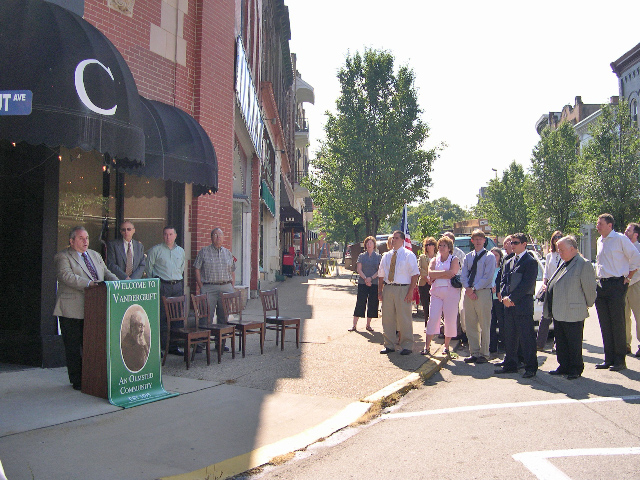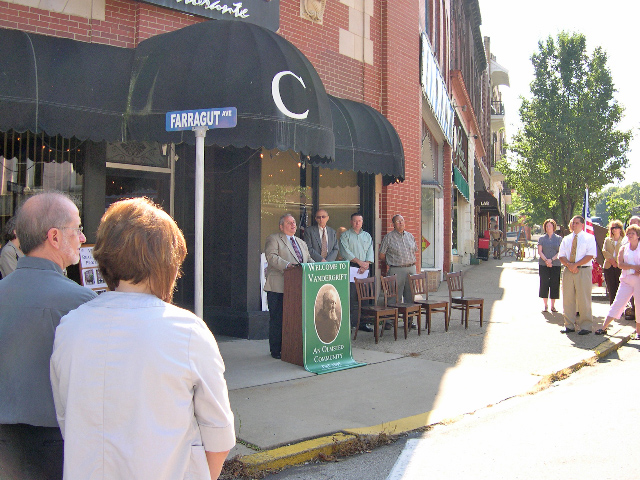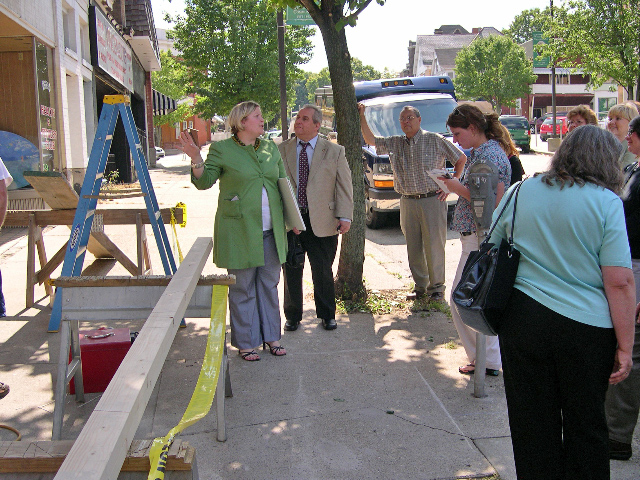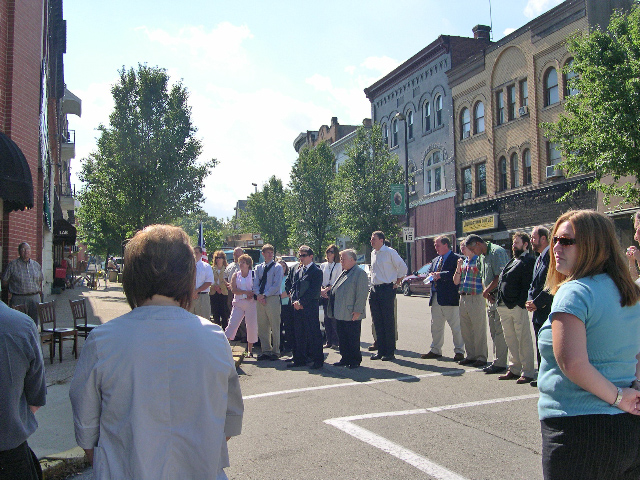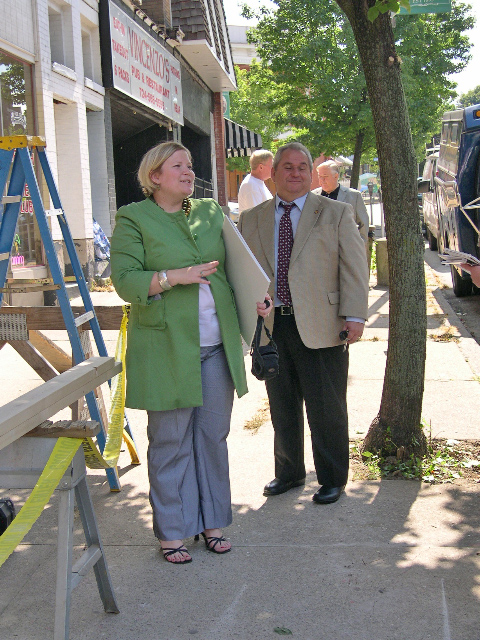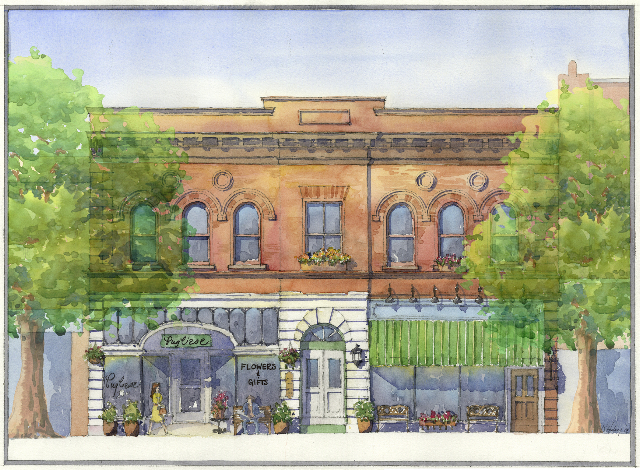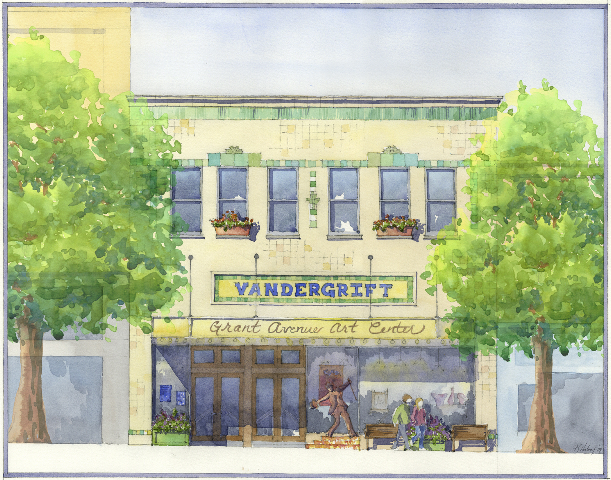
Category Archive: Legislative / Advocacy
-
Public Hearing at Historic Review Commission on 200-210 Fifth Avenue, and 438 & 440 Market Street
PREPARED TESTIMONY OFANNE E. NELSON, ESQ.
GENERAL COUNSEL
PITTSBURGH HISTORY & LANDMARKS FOUNDATION
BEFORE HISTORIC REVIEW COMMISSION, CITY OF PITTSBURGH
PUBLIC HEARING ON 200-210 FIFTH AVENUE; 438 & 440 MARKET STREET
NOVEMER 5, 2008
As the future holder of a preservation easement on the Buhl Building and current holder of design control rights on the adjacent properties, Landmarks supports N&P Properties’ plans to rehabilitate the exterior of the Buhl Building, demolish the adjacent structures, and build a new building adjacent to the Buhl. The size, scale, and color of the proposed adjacent building compliment the blue terra cotta Buhl Building. Landmarks’ support of N & P Properties’ plans for the Buhl Building and adjacent structures, however, is contingent on the Pennsylvania Historical and Museum Commission approving Part 2 of their Federal Rehabilitation Tax Credit application.
-
Public Hearing Before Historic Review Commission on 4420 Bayard Street
PREPARED TESTIMONY OF
ANNE E. NELSON, ESQ.
GENERAL COUNSEL
PITTSBURGH HISTORY & LANDMARKS FOUNDATION
BEFORE HISTORIC REVIEW COMMISSION, CITY OF PITTSBURGH
PUBLIC HEARING ON 4420 BAYARD STREET, THE ELMHURST GROUP
OCTOBER 1, 2008
Pittsburgh History & Landmarks Foundation has reviewed the Elmhurst Group’s plans for a new office building in the parking lot behind and owned by the First Baptist Church in Oakland. We appreciate the very good efforts of the Elmhurst Group in regard to the planning and redesign of the structure. In particular, the building’s height, materials, and setback on Bayard Street are in accordance with the other buildings on the street and harmonize the building with the Church. The higher portion of the building along Ruskin Avenue complements the Ruskin Apartment and its materials and to some degree its style.
However, we have the following concerns with the building:
1. The top portion of the seven-story building should be redesigned without the projecting central overhang, which is something of a cliché in modern design. We also suggest that the stringcourse be continued across the Bayard/Bigelow façade just as it does on the Ruskin Avenue façade and with the elongated windows eliminated. We believe that such detailing is inappropriate next to the architecturally-significant First Baptist Church, the Ruskin Apartment Building and the houses of Schenley Farms.
2. We recommend that the walkway around the building be planted with sycamore trees instead of columnar trees as shown. We would be happy to meet with the City Forester to discuss the matter of tree selection. A few columnar trees were planted years ago further west on Bayard Street and they are still nothing more than elongated toothpicks with a few leaves attached. Sycamore trees, used throughout Schenley Farms, arch up over the streets and provide a canopy of elegance, beauty, and shade.
We continue also to have a significant concern with the Historic Review Commission’s jurisdiction and ability to review new construction in historic districts. We hope this matter can be resolved or clarified so as not to cause issues with other new construction projects in historic districts.
-
Vandergrift Main Street Gets Lift
by Shaun Yurcaba
Pittsburgh History & Landmarks Foundation
September 8, 2008Sen. Jim Ferlo announced today a $35,000 grant to assist the Vandergrift Main Street program. This grant will be added to the Restoration Revolving Fund, which was created in 2006 to bring new life to downtown Vandergrift and to restore its distinctive buildings. The Revolving Fund was initially capitalized with a $300,000 grant from the Allegheny Foundation, a charitable entity of Richard M. Scaife.
In addition, the Vandergrift Improvement Program (VIP), Inc., a non-profit organization, announced the acquisition of two new buildings in the heart of downtown Vandergrift, and the restoration of a third building, all utilizing the original Scaife grant to establish the Revolving Fund.
“The VIP is using the Restoration Revolving Fund so effectively that I am very pleased to add additional state resources to it for further leverage,” said Sen. Ferlo.
143 Grant Ave: The VIP purchased 143 Grant Ave. in 2007 and has completed a complete masonry and storefront restoration of the facade. The roof has been replaced. The VIP is in negotiations with a tenant who plans to open a bakery and yoga studio on the first floor and live above in the second floor residential unit.
139/141 Grant Ave: The VIP has just secured 139-141 Grant Avenue. The roof, which had been severely compromised, has already been replaced. The VIP is also upgrading the electrical system and plans to fully restore the facade. Long term plans include renovating the 5 second floor apartments, which are uninhabitable.
134 Grant Ave: The VIP also just secured 134 Grant Avenue (the former JC Penny’s Building). The VIP has cleared the building of debris and is working on a long term plan to locate a Community Art Center and a small business incubator in this space.
According to Meade Jack, President of the VIP, downtown Vandergrift has reached a tipping point. “We have invested a lot of time and hard work in this effort. But it’s been well worth it. The seeds we’ve planted the last several years are now starting to bear fruit. We have a long way to go but we are on the right track,” Jack said. “We are demonstrating that there is still plenty of life in Pennsylvania’s small towns.”
The VIP began in 2003 with a grant from Sen. Ferlo and received DCED Main Street designation in 2006. The main street program is in year three and is being managed in partnership with the Pittsburgh History and Landmarks Foundation (PHLF).
- Arthur P. Ziegler, Jr.
- Shaun Yurcaba and Senator Jim Ferlo
- Vandergrift Flower Shop Rendering
- Vandergrift Art Center Rendering
-
‘Lazarus’ on the Hill?
By Glen Meakem
Pittsburgh Tribune Review
Sunday, August 31, 2008In 1998, Pittsburgh celebrated as the “glitzy” new Lazarus department store opened on Fifth Avenue, Downtown. In the spring of 2004, after just five years, Pittsburghers mourned as the store closed its doors forever — another blow to a city struggling to succeed.
Now Pittsburgh politicians and community leaders face another economic decision — which grocery store to build in the Hill District. I am hoping, for the sake of Hill residents and city taxpayers of all neighborhoods, that our leaders will choose the best long-term economic answer instead of short-term glitz.
The Lazarus project was a costly mistake. In order to attract the store, the Urban Redevelopment Authority lent Lazarus $18 million and the city provided $5 million in additional cash. Despite the large government subsidies, once construction was completed and the doors opened, sales were well below expectations.
Lazarus was obligated to begin repaying the $18 million loan once in-store sales reached $41 million per year. But peak sales never exceeded $22 million. The taxpayer loan never was repaid. Even with more than $20 million of government subsidies, Lazarus sustained big losses and was forced to close.
The truth is Lazarus might have worked if marketproblems — high parking taxes and the lack of downtown residential living — had been addressed first. Instead, politicians chose a reality-ignoring strategy that cost taxpayers tens of millions of dollars and dealt Pittsburgh a tough blow.
The first proposal for the Hill District grocery store is being presented by St. Louis-based grocer Save-A-Lot. Its store is economically viable, based on a business model that works and experience with more than 1,200 stores around the country.
Save-A-Lot deliberately keeps its stores smaller than other grocers, eliminating amenities such as on-site bakeries, pharmacies and dry cleaners. It also limits inventory to approximately 1,200 frequently purchased items — what the corporation refers to as an “edited assortment.”
By keeping its stores small, forgoing amenities that increase the costs of doing business, and stocking only the most popular items in the most commonly purchased sizes, Save-A-Lot claims it saves customers 40 percent on food purchases.
The company is experienced in providing quality service to urban markets like the Hill District. According to Mayor John Thompson of Wilkinsburg, where a Save-A-Lot opened in 2007, the store has surpassed the community’s expectations, providing not only quality food at low prices but also many jobs to community residents and financial support to local charity efforts.
Save-A-Lot says it would not be economically viable to build a full-service grocery store on the Hill. But the small size of the proposed building project (16,500 square feet) would allow additional businesses to move into the Center Avenue location over time (such as a pharmacy), complementing the smaller grocer.
The new Save-A-Lot building is projected to cost $5 million to $6 million and can be up and running in less than a year.
The second proposal, presented by Kuhn’s, is not based on experience or a proven business model.
Similar to the “glitz” of Lazarus, this proposal calls for a $24 million revitalization project that includes a 50,000-square-foot Kuhn’s Market, among other stores. The plan surprised many, since Kuhn’s previously stated — along with Giant Eagle and Aldi — that it was not interested in building a grocery store on the Hill.
Unlike Save-A-Lot, Kuhn’s is a local, family-owned business with eight locations but no experience in urban markets. Yet some community leaders and activists see this more ambitious plan — including a pharmacy, bakery, deli, meat counter and fresh fish section — as a better fit for the neighborhood.
The proposed Kuhn’s project would require an as-yet-unspecified level of taxpayer support above the $2 million in subsidies already promised by the URA and the Pittsburgh Penguins.
Before making their decision, Pittsburgh leaders also should consider one more set of facts: Grocery shopping habits are changing all over the country.
According to a 2007 Gallup Poll, 46 percent of adults say higher food costs are creating financial hardships.
Prices climbed 5 percent in 2007 and 6 percent in 2008 (the largest single-year jump since 1990).
Americans are now buying fewer luxury food items and more store brands.
According to Willard Bishop, a Barrington, Ill., consulting firm, limited-assortment grocery stores such as Save-A-Lot enjoyed an increase in sales of more than 16 percent last year while sales at full-service grocery stores rose only 3 percent.
The Save-A-Lot proposal is in line with current trends while the Kuhn’s proposal runs against them.
The last few days of summer are upon us and community leaders are struggling to make the right decision between two very different grocery store proposals. Will this generation of leaders choose the proven business concept from the company with experience that is likely to serve the Hill community for many years to come?
Or, as their predecessors did with Lazarus, will they choose the expensive, unproven model from a company relying on big government subsidies with no experience in the market it is entering?
In the business world, we call this decision a “no-brainer.” Political and community leaders should choose the commonsense solution over government-subsidized “glitz” and go with Save-A-Lot.
Hill District residents and city taxpayers from all neighborhoods will thank them for it.
Glen Meakem, founder and original CEO of FreeMarkets Inc., a business-to-business Internet company Downtown, is co-founder and managing director of Meakem Becker Venture Capital.
-
Council grants North Side temple historic status
By Jeremy Boren
TRIBUNE-REVIEW
Wednesday, August 6, 2008Pittsburgh City Council Tuesday sought to end a long-simmering controversy by dubbing the former Malta Temple building in the North Side a historic structure.
The decision will protect the stately brick building on West North Avenue from demolition, but it also could prompt legal action from the Salvation Army, which has owned the former social club since the 1970s.
Salvation Army officials have fought the historic designation because they want to raze the edifice to make way for a larger $5 million facility on the same street. The nonprofit organization runs a social services center in the 81-year-old building, which officials say would be too costly to renovate.
Salvation Army officials last week said they might challenge City Council’s decision in court.
“We are very disappointed in the vote,” said Maj. Robert J. Reel, the organization’s Western Pennsylvania divisional commander. “And we are exploring our options.”
Members of the Mexican War Streets Society, a neighborhood group, said they nominated the Malta Temple building for historic status to preserve the neighborhood’s historic appeal.
In a final decision, City Council voted 8-1 in favor of the designation, with Councilman Ricky Burgess casting the lone dissenting vote.
Burgess argued historic designation should not be forced upon the building because it serves as a place of religious worship.
Jeremy Boren can be reached at jboren@tribweb.comor 412-765-2312.
-
Public Hearing at Historic Review Commission on Redesign of Market Square
PREPARED TESTIMONY OF
ANNE E. NELSON, ESQ.
GENERAL COUNSEL
PITTSBURGH HISTORY & LANDMARKS FOUNDATION
BEFORE HISTORIC REVIEW COMMISSION, CITY OF PITTSBURGH
PUBLIC HEARING ON MARKET SQUARE REDESIGN
JULY 2, 2008
Landmarks is investing $3.5 million to restore four historic buildings in Market Square located between Market and Graeme Streets, the design of which was predicated on Market and Graeme being open to vehicular traffic from Fifth Avenue into the Square. This project includes retail on the first floor and seven affordable apartments on the upper floors that will use Graeme Street as an entrance. We will have a green roof and are doing the buildings to LEED standards.
However, the redesign plans chosen close Graeme Street and that has us alarmed. We do not see how people are going to want to rent apartments on a dead end street. People do not frequent dead end streets; they want the ability to bring people to the door, load and unload things. Furthermore, how will the trash be collected?
Historically, Market Square has always had full traffic access. Removing traffic from the street has worked almost nowhere in the United States and almost every street where traffic was removed has been reconverted to have traffic flowing again in order to bring people back. Examples of traffic removed include East Liberty and Allegheny Center in Pittsburgh, and traffic was eliminated on Chestnut Street in Philadelphia and Fourth Street in Louisville and both lost retail and now have it back since traffic was reopened.
If Graeme Street is closed, Landmarks does not know whether it should complete construction of the project. I ask you, would you like to live on a dead end street that has no provisions for dropping off or turning around? When thinking about this question, remember that in Pittsburgh during a lengthy part of the year, the days are short and the weather is bad.
We question our investment of $3.5 million in Market Square if Graeme Street is closed.
-
Public Hearing on St. Mary’s Academy Building
PREPARED TESTIMONY OF
ANNE E. NELSON, ESQ.
GENERAL COUNSEL
PITTSBURGH HISTORY & LANDMARKS FOUNDATION
BEFORE HISTORIC REVIEW COMMISSION, CITY OF PITTSBURGH
PUBLIC HEARING ON ST. MARY’S ACADEMY BUILDING
CITY HISTORIC STRUCTURE NOMINATION
JULY 2, 2008
Pittsburgh History & Landmarks Foundation (Landmarks) strongly supports the nomination of the Academy Building of the St. Mary’s Church complex to become a City-Designated Historic Structure.
The St. Mary’s Academy Building was listed on the first county-wide architectural survey conducted in the United States, undertaken by Landmarks in 1966, and chosen as one of the buildings published in Landmark Architecture of Allegheny County Pennsylvania by James D. Van Trump and Arthur P. Ziegler, Jr. The Academy Building was also listed in 1979 in the second countywide survey of historic architectural sites conducted by Landmarks, in association with the Commonwealth of Pennsylvania. It was chosen for inclusion as one of 600 out of the 10,000 surveyed in the major book based on this survey, Pittsburgh’s Landmark Architecture by Walter C. Kidney, published in 1997. Both Van Trump and Kidney consider the Greek Revival c. 1850 Academy Building a significant surviving example of an important American architectural style. Furthermore, its “curious ornamental cast iron porch” is “the sort usually associated with New Orleans or Mobile although once common too in the industrial North.”
In 1989 historian Roger Kennedy noted in his National Trust book Greek Revival America: “The Northern Greek Revival was at least as vigorous and diverse as that in the antebellum South; but all the great houses of the North … have fallen victim to that region’s industrial success.” This is also true of banks, courthouses, and modest Greek Revival structures like St. Mary’s Academy, and we should protect the limited number of survivors.
Of the buildings in the St. Mary’s Church complex, the Academy Building is not only the oldest, but is the most architecturally unique and should, therefore, be deemed a City-Historic Structure.
-
Public Hearing at City of Pittsburgh Council on the Malta Temple City Historic Structure Nomination
PREPARED TESTIMONY OF
ANNE E. NELSON, ESQ.
GENERAL COUNSEL
PITTSBURGH HISTORY & LANDMARKS FOUNDATION
BEFORE THE PITTSBURGH CITY COUNCIL
PUBLIC HEARING ON THE MALTA TEMPLE
CITY HISTORIC STRUCTURE NOMINATION
June 25, 2008
Pittsburgh History & Landmarks Foundation supports the nomination of the Malta Temple Building to be a city-designated historic structure.
The former meeting house of the Ancient and Illustrious Order of the Knights of Malta is noteworthy for its historical and architectural character. Furthermore, the building’s location, as part of the continuous streetscape of the historic North Avenue next door to the Federal North block, which is also significant. Therefore, the Malta Temple Building should be preserved for the benefit of the residents of Pittsburgh.
The Salvation Army intends to replace the current structure with a building that is almost identical in style and design to the current structure. The reason for the new building is that the existing floor plates do not support the services the Salvation Army needs to offer at that location. Landmarks is currently rehabilitating four historic buildings in Market Square and has altered the floor plates and interiors to meet the new uses of the building. This is done with numerous historic properties.
Landmarks offers its assistance to the Salvation Army in planning to reuse the structure.

